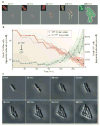Using movies to analyse gene circuit dynamics in single cells
- PMID: 19369953
- PMCID: PMC2853934
- DOI: 10.1038/nrmicro2056
Using movies to analyse gene circuit dynamics in single cells
Abstract
Many bacterial systems rely on dynamic genetic circuits to control crucial biological processes. A major goal of systems biology is to understand these behaviours in terms of individual genes and their interactions. However, traditional techniques based on population averages 'wash out' crucial dynamics that are either unsynchronized between cells or are driven by fluctuations, or 'noise', in cellular components. Recently, the combination of time-lapse microscopy, quantitative image analysis and fluorescent protein reporters has enabled direct observation of multiple cellular components over time in individual cells. In conjunction with mathematical modelling, these techniques are now providing powerful insights into genetic circuit behaviour in diverse microbial systems.
Figures





Similar articles
-
Use of fluorescence microscopy to analyze genetic circuit dynamics.Methods Enzymol. 2011;497:275-93. doi: 10.1016/B978-0-12-385075-1.00013-5. Methods Enzymol. 2011. PMID: 21601092
-
Analytics and visualization tools to characterize single-cell stochasticity using bacterial single-cell movie cytometry data.BMC Bioinformatics. 2021 Oct 29;22(1):531. doi: 10.1186/s12859-021-04409-9. BMC Bioinformatics. 2021. PMID: 34715773 Free PMC article.
-
TLM-Tracker: software for cell segmentation, tracking and lineage analysis in time-lapse microscopy movies.Bioinformatics. 2012 Sep 1;28(17):2276-7. doi: 10.1093/bioinformatics/bts424. Epub 2012 Jul 5. Bioinformatics. 2012. PMID: 22772947
-
Stochastic Switching of Cell Fate in Microbes.Annu Rev Microbiol. 2015;69:381-403. doi: 10.1146/annurev-micro-091213-112852. Epub 2015 Aug 21. Annu Rev Microbiol. 2015. PMID: 26332088 Review.
-
Functional roles of pulsing in genetic circuits.Science. 2013 Dec 6;342(6163):1193-200. doi: 10.1126/science.1239999. Science. 2013. PMID: 24311681 Free PMC article. Review.
Cited by
-
Quantitative microbiology with widefield microscopy: navigating optical artefacts for accurate interpretations.Npj Imaging. 2024;2(1):26. doi: 10.1038/s44303-024-00024-4. Epub 2024 Sep 2. Npj Imaging. 2024. PMID: 39234390 Free PMC article.
-
Monitoring lineages of growing and dividing bacteria reveals an inducible memory of mar operon expression.Front Microbiol. 2023 Jun 20;14:1049255. doi: 10.3389/fmicb.2023.1049255. eCollection 2023. Front Microbiol. 2023. PMID: 37485524 Free PMC article.
-
Live-cell imaging of cyanobacteria.Photosynth Res. 2015 Oct;126(1):33-46. doi: 10.1007/s11120-014-0049-x. Epub 2014 Nov 4. Photosynth Res. 2015. PMID: 25366827 Review.
-
From measuring noise toward integrated single-cell biology.Front Genet. 2014 Nov 19;5:408. doi: 10.3389/fgene.2014.00408. eCollection 2014. Front Genet. 2014. PMID: 25477903 Free PMC article. No abstract available.
-
Determining growth rates from bright-field images of budding cells through identifying overlaps.Elife. 2023 Jul 7;12:e79812. doi: 10.7554/eLife.79812. Elife. 2023. PMID: 37417869 Free PMC article.
References
-
- Marcus JS, Anderson WF, Quake SR. Microfluidic single-cell mRNA isolation and analysis. Anal Chem. 2006;78:3084–9. - PubMed
-
- Dickinson ME, Bearman G, Tille S, Lansford R, Fraser SE. Multi-spectral imaging and linear unmixing add a whole new dimension to laser scanning fluorescence microscopy. Biotechniques. 2001;31:1272, 1274–6, 1278. - PubMed
-
- Reddy GV, Heisler MG, Ehrhardt DW, Meyerowitz EM. Real-time lineage analysis reveals oriented cell divisions associated with morphogenesis at the shoot apex of Arabidopsis thaliana. Development. 2004;131:4225–37. - PubMed
-
- Megason SG, Fraser SE. Imaging in systems biology. Cell. 2007;130:784–95. - PubMed
Publication types
MeSH terms
Grants and funding
LinkOut - more resources
Full Text Sources
Other Literature Sources

